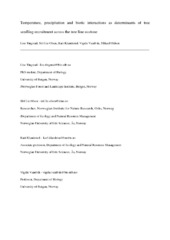| dc.contributor.author | Tingstad, Lise | |
| dc.contributor.author | Olsen, Siri Lie | |
| dc.contributor.author | Klanderud, Kari | |
| dc.contributor.author | Vandvik, Vigdis | |
| dc.contributor.author | Ohlson, Mikael | |
| dc.date.accessioned | 2017-11-24T10:45:47Z | |
| dc.date.available | 2017-11-24T10:45:47Z | |
| dc.date.issued | 2015-10 | |
| dc.Published | Tingstad L, Olsen SL, Klanderud K, Vandvik V, Ohlson M. Temperature, precipitation and biotic interactions as determinants of tree seedling recruitment across the tree line ecotone. Oecologia. 2015;179:599-608 | eng |
| dc.identifier.issn | 0029-8549 | en_US |
| dc.identifier.issn | 1432-1939 | en_US |
| dc.identifier.uri | https://hdl.handle.net/1956/16955 | |
| dc.description.abstract | Seedling recruitment is a critical life history stage for trees, and successful recruitment is tightly linked to both abiotic factors and biotic interactions. In order to better understand how tree species’ distributions may change in response to anticipated climate change, more knowledge of the effects of complex climate and biotic interactions is needed. We conducted a seed-sowing experiment to investigate how temperature, precipitation and biotic interactions impact recruitment of Scots pine (Pinus sylvestris) and Norway spruce (Picea abies) seedlings in southern Norway. Seeds were sown into intact vegetation and experimentally created gaps. To study the combined effects of temperature and precipitation, the experiment was replicated across 12 sites, spanning a natural climate gradient from boreal to alpine and from sub-continental to oceanic. Seedling emergence and survival were assessed 12 and 16 months after sowing, respectively, and aboveground biomass and height were determined at the end of the experiment. Interestingly, very few seedlings were detected in the boreal sites, and the highest number of seedlings emerged and established in the alpine sites, indicating that low temperature did not limit seedling recruitment. Site precipitation had an overall positive effect on seedling recruitment, especially at intermediate precipitation levels. Seedling emergence, establishment and biomass were higher in gap plots compared to intact vegetation at all temperature levels. These results suggest that biotic interactions in the form of competition may be more important than temperature as a limiting factor for tree seedling recruitment in the sub- and low-alpine zone of southern Norway. | en_US |
| dc.language.iso | eng | eng |
| dc.publisher | Springer | en_US |
| dc.subject | Seed-sowing experiment | eng |
| dc.subject | Climate gradients | eng |
| dc.subject | Picea abies | eng |
| dc.subject | Pinus sylvestris | eng |
| dc.title | Temperature, precipitation and biotic interactions as determinants of tree seedling recruitment across the tree line ecotone | en_US |
| dc.type | Peer reviewed | |
| dc.type | Journal article | |
| dc.date.updated | 2017-09-26T10:36:34Z | |
| dc.description.version | acceptedVersion | en_US |
| dc.rights.holder | Copyright Springer-Verlag Berlin Heidelberg 2015 | en_US |
| dc.identifier.doi | https://doi.org/10.1007/s00442-015-3360-0 | |
| dc.identifier.cristin | 1249018 | |
| dc.source.journal | Oecologia | |
| dc.relation.project | Norges forskningsråd: 184636 | |
| dc.relation.project | Norges forskningsråd: 184912 | |
| dc.subject.nsi | VDP::Matematikk og naturvitenskap: 400::Zoologiske og botaniske fag: 480::Økologi: 488 | |
| dc.subject.nsi | VDP::Mathematics and natural scienses: 400::Zoology and botany: 480::Ecology: 488 | |
